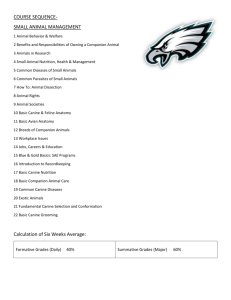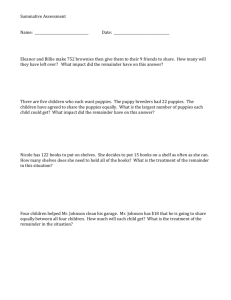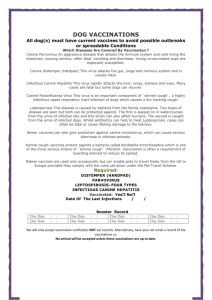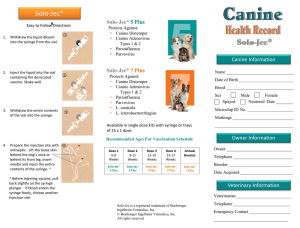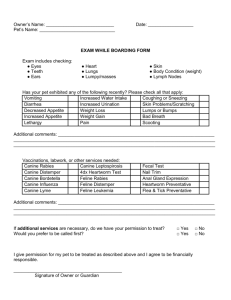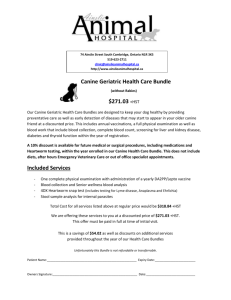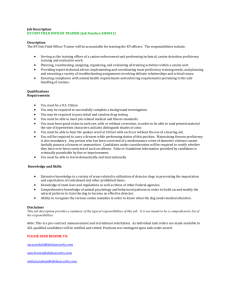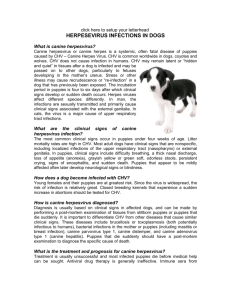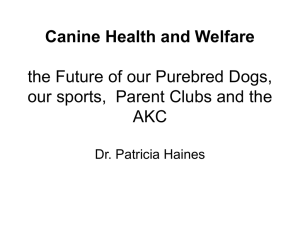canine_parvovirus_infection
advertisement
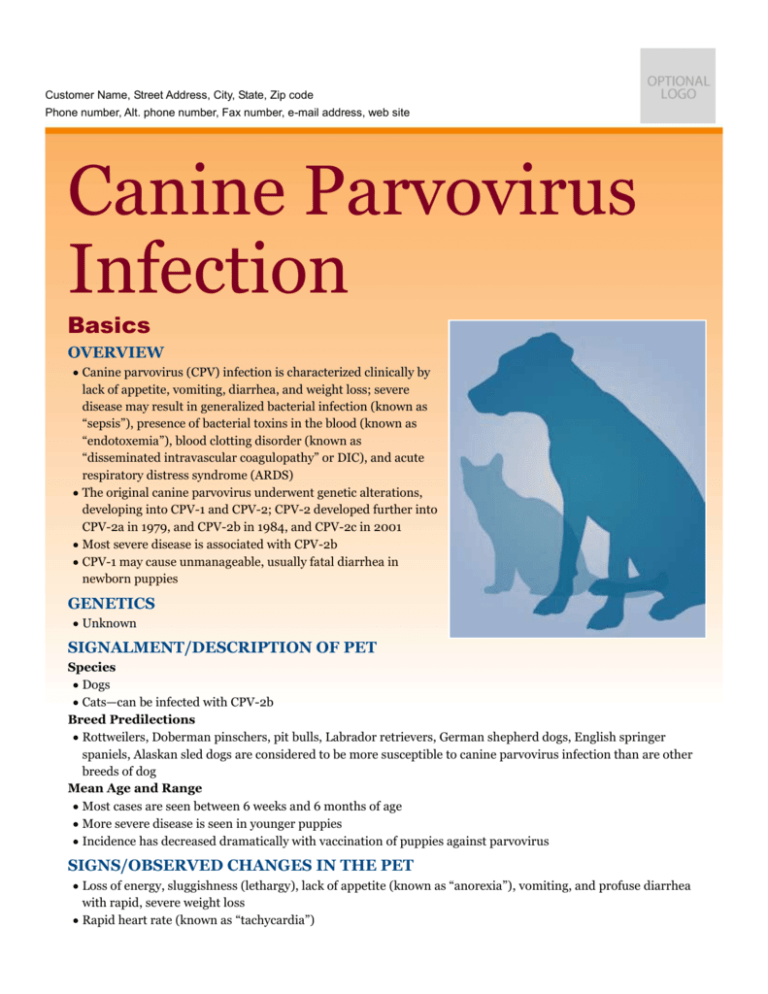
Customer Name, Street Address, City, State, Zip code Phone number, Alt. phone number, Fax number, e-mail address, web site Canine Parvovirus Infection Basics OVERVIEW • Canine parvovirus (CPV) infection is characterized clinically by lack of appetite, vomiting, diarrhea, and weight loss; severe disease may result in generalized bacterial infection (known as “sepsis”), presence of bacterial toxins in the blood (known as “endotoxemia”), blood clotting disorder (known as “disseminated intravascular coagulopathy” or DIC), and acute respiratory distress syndrome (ARDS) • The original canine parvovirus underwent genetic alterations, developing into CPV-1 and CPV-2; CPV-2 developed further into CPV-2a in 1979, and CPV-2b in 1984, and CPV-2c in 2001 • Most severe disease is associated with CPV-2b • CPV-1 may cause unmanageable, usually fatal diarrhea in newborn puppies GENETICS • Unknown SIGNALMENT/DESCRIPTION OF PET Species • Dogs • Cats—can be infected with CPV-2b Breed Predilections • Rottweilers, Doberman pinschers, pit bulls, Labrador retrievers, German shepherd dogs, English springer spaniels, Alaskan sled dogs are considered to be more susceptible to canine parvovirus infection than are other breeds of dog Mean Age and Range • Most cases are seen between 6 weeks and 6 months of age • More severe disease is seen in younger puppies • Incidence has decreased dramatically with vaccination of puppies against parvovirus SIGNS/OBSERVED CHANGES IN THE PET • Loss of energy, sluggishness (lethargy), lack of appetite (known as “anorexia”), vomiting, and profuse diarrhea with rapid, severe weight loss • Rapid heart rate (known as “tachycardia”) • Moist tissues of mouth and eyes (known as “mucous membranes”) may be pale or deep red, due to the blood vessels being filled with blood (known as being “injected”), or yellowish (known as being “icteric” or “jaundiced”) • Dehydration • Pain or discomfort when the veterinarian feels the abdomen (known as “abdominal palpation”) • Intestines may be fluid filled, or rarely, the veterinarian may detect the folding of one segment of the intestine into another segment (known as “intussusception”) • May have a fever or the body temperature may be lower than normal (known as “hypothermia”) • May exhibit vomiting/diarrhea in the examination room CAUSES • CPV-2b (canine parvovirus-2b) infection RISK FACTORS • Breed predisposition as listed under “Breed Predilections” • Possible simultaneous conditions, diseases or drug therapy that lead to an inability to develop a normal immune response (known as “immunosuppression”), such as heavy parasitism • Incomplete vaccination protocol, vaccine failure, or normal interference of the puppy developing protective antibodies due to the presence of maternal antibodies • Breeding kennels, pounds, shelters, and areas with a high number of puppies without adequate immune response or inadequately vaccinated puppies Treatment HEALTH CARE • Hospitalization for intensive therapy and supportive treatment significantly improves survival • Hospitalized pets must be kept isolated from other pets; hospital personnel must follow proper cleaning and disinfecting practices to prevent spread of the virus • Intravenous fluid therapy is a mainstay of treatment; fluid rates must account for maintenance needs plus ongoing losses, which may be profound due to vomiting and diarrhea • Colloid therapy (using certain fluids with larger molecular weight substances than found in typical IV fluids to expand the plasma volume) may be necessary in pets with low levels of albumin (a protein) in the blood (condition known as “hypoalbuminemia”) • Transfusions with plasma or hyperimmune serum may be used ACTIVITY • Activity should be restricted until puppies are recovering DIET • Food and water should be withheld if vomiting • Small amounts of water may be introduced after 24 hours with no vomiting • Nutrition utilizing some type of feeding tube (known as “enteral nutrition” or “microenteral nutrition”) should be considered in pets with lack of appetite (anorexia) of 3–4 days in duration; early enteral nutrition may improve clinical outcome • Providing nutrition via intravenous therapy (known as “parenteral nutrition”) may be required in severely affected pets • Glutamine supplementation has been shown to improve the health of intestinal cells • A bland, easily digestible diet (such as Hill's Prescription Diet i/d, Purina Veterinary Diets EN) should be fed initially, with gradual transition to the normal ration SURGERY • The only surgical indication is for treatment of the rare complication of intestinal intussusception (the folding of one segment of the intestine into another segment) Medications Medications presented in this section are intended to provide general information about possible treatment. The treatment for a particular condition may evolve as medical advances are made; therefore, the medications should not be considered as all inclusive • Drugs to stop vomiting (known as “antiemetics”)—very frequently needed due to prolonged vomiting; examples include metoclopramide; serotonin receptor antagonists, such as ondansetron; and neurokinin receptor antagonists, such as maropitant • H2-blockers—may reduce nausea; such as cimetidine; ranitidine; famotidine • Antibiotics—to combat generalized bacterial infection (known as “sepsis”); should have antibiotic spectrum to include gram-negative organisms; gram staining is a technique in which slides with potential bacteria on them are stained in a sequential manner; gram-positive bacteria stain dark purple while gram-negative bacteria stain pink; gram staining allows differentiation of bacteria into groups (that is, gram-positive or gram-negative) • Medications (known as “anthelmintics”) to eradicate intestinal parasites • Pain relievers (known as “analgesics”)—may be needed in severely affected pets • Anecdotal reports describe the use of equine endotoxin antiserum; no controlled studies demonstrate a survival benefit with this therapy • Recent studies have shown no survival benefit in using granulocyte colony-stimulating factor, anti–tumor necrosis factor (anti-TNF), or recombinant bactericidal/permeability–increasing protein (rBPI21) • Less severely affected puppies may be managed on an outpatient basis with fluids administered under the skin (known as “subcutaneous fluid administration”) and/or into the abdominal cavity (known as “intraperitoneal fluid administration”), if owner has financial constraints Follow-Up Care PATIENT MONITORING • Frequent rechecks and physical examinations during treatment PREVENTIONS AND AVOIDANCE • Vaccination against canine parvovirus has been effective at drastically reducing disease incidence • Modified live (high-titer) vaccines are recommended for puppies to minimize interference from maternal antibodies • Interference from maternal antibodies is the main reason for vaccine failure; some puppies may have maternal antibodies present in their blood for up to 18 weeks of age • Protocols recommend vaccinating at 6, 9, and 12 weeks of age • High-risk breeds may require a longer initial vaccination protocol against canine parvovirus, extending up to 22 weeks of age • Recent studies indicate immunity may last 3+ years after completion of the initial vaccine protocol POSSIBLE COMPLICATIONS • Generalized bacterial infection (sepsis) • Presence of bacterial toxins in the blood (endotoxemia) • Shock • Intussusception (the folding of one segment of the intestine into another segment) • Blood clotting disorder (disseminated intravascular coagulopathy) • Acute respiratory distress syndrome (ARDS) EXPECTED COURSE AND PROGNOSIS • If the puppy recovers, recovery is typically complete; immunity following canine parvovirus infection is long term and may be lifelong • Mortality is primarily due to the presence of bacterial toxins in the blood (endotoxemia) • Aggressive therapy improves survival, but mortality rates may still approach 30% Key Points • Canine parvovirus is very stable in the environment, but may be destroyed by use of 1:30 bleach solution • Vaccination does not produce immediate immunity, so susceptible puppies should be kept isolated • Mortality is primarily due to the presence of bacterial toxins in the blood (endotoxemia) • Aggressive therapy improves survival, but mortality rates may still approach 30% Enter notes here Blackwell's Five-Minute Veterinary Consult: Canine and Feline, Fifth Edition, Larry P. Tilley and Francis W.K. Smith, Jr. © 2011 John Wiley & Sons, Inc.
